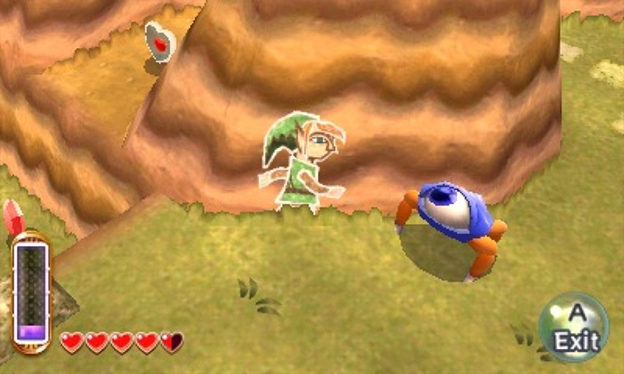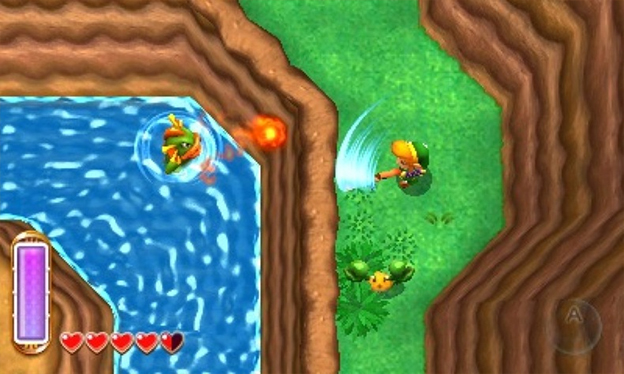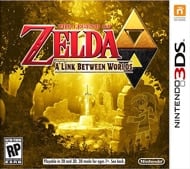Linked From The Past
A new Zelda game is always cause for celebration. Even ports of the classic games in the series— Ocarina of Time, A Link to the Past, and the lesser known Oracle games—result in rejoicing throughout the gamer community. Wind Waker, likely the most polarizing Zelda title in recent memory, is being remade in HD for the Wii U this holiday season, and that has people talking (as does the intimation that Nintendo is working on an original entry in the franchise for that console).
But what really has the Nintendo faithful going is the entirely new 3DS Zelda title, announced only weeks in advance of E3, but playable on the show floor. The Legend of Zelda: A Link Between Worlds has a title that echoes that most renowned of top-down Zelda adventures, and with good reason. It is actually a direct sequel to A Link to the Past, one that goes so far as to share that game’s classic enemies and overworld, even drawing from its art direction. This is the first handheld Zelda in a while in which Link does not look as he did in his Wind Waker or Four Swords incarnations, eschewing the blond, spiky hair for a brown pompadour in deference to the hand-drawn images of the character in the original instruction books for the NES and SNES Zelda games.
In fact, this feels very much like a throwback to the days of yore. Departing from Link’s familiar house, just south of Hyrule’s castle, I soon found myself in combat with green knights and crows. As I navigated the nearly identical plains of Hyrule to the desert ruins in the southeast, the location of the original first temple in A Link to the Past, I began to see Octoroks and Buzz Blobs, faithfully reproduced in full 3D. The ruins themselves housed the familiar knight statues, which came alive when I brushed by them in my attempts to pass. Later, in the dungeon portion of the demo, I would encounter hardhat enemies and the infamous Stalfos, just as frustrating with its frequent jumping as in days of yore.

The overworld demo ended just as I got to what I presumed to be the entrance of the first dungeon, but even this brief glimpse of the game was enough to see that many tweaks and additions had been made to the basic gameplay. Gone are the stylus-based controls of the DS titles, replaced with a more traditional buttons-and-analog-slider system. That slider is important as, though this is still very much a top-down Zelda, it does not restrict movement to four directions, allowing you to aim Link any which way, which is beneficial for the feel of the controls, but adds additional complexity into the use of ranged attacks, which may now fire off at slightly skewed angles. This applied, in the demo, to both the arrows and to Link’s sword, which could fire the familiar arc of energy at foes when he was at full health.

Missing a shot, though, is no longer as big a deal as it was in the past. Neither is placing bombs, whether in combat or just to hunt down secret crevices in the landscape. Bombs and arrows are no longer a limited resource carried about in one’s inventory, instead drawing from Link’s magic meter when either weapon is used. Unlike A Link to the Past, in which the magic meter was a similarly finite resource that had to be recharged by picking up potions, the one in A Link Between Worlds refills automatically over a brief stretch of time. This is a particular blessing given the game’s new Merging mechanic.
Briefly touched upon during the game’s initial reveal, Merging is an ability by which Link can flatten himself against flat walls, becoming a chalk-like drawing on their surface. He can then navigate along them, taking any turns or curves as long as there is nothing irregularly jutting out from the wall to obstruct his progress. This can be done on any qualifying surface with a simple press of a button. It doesn’t appear that Link can be damaged while in this state, but his magic meter drains constantly as long as he is in it.

Though I used this skill on the overworld to reach a few seemingly unattainable items, the best implementation of it showed up in the dungeon segment of the demo. It isn’t clear how far into the game this demo dungeon is placed, though I’d wager it’s there in lieu of the original third dungeon, given its red/blue tile switches and tremendous verticality. As I began my climb through the narrow tower, I soon found myself merging with a wall and slipping through a grated window to the outside of the dungeon, where platforms moved on automated routes along the outer wall. Here, the Merging mechanic became less a means of navigation and more one of survival. A platform I was riding would slide under a solid, stone barrier, at which point I had to quickly merge with it and slip around to the other side, waiting there for the platform to emerge once more. There’s a certain tension to that experience, the magic meter running down, the platform makings its way beneath the barrier at a snail’s pace; it’s a testament to Nintendo’s design acumen that, even when you know you’re doing the right thing, you aren’t entirely sure you’ll succeed.
The demo, as a whole, was all too brief. I was left hankering for more, and am definitely excited not only to see how the Merging mechanic is iterated upon throughout the game, but also what unique items and abilities Link will come to possess throughout his journey.
Game Features:
